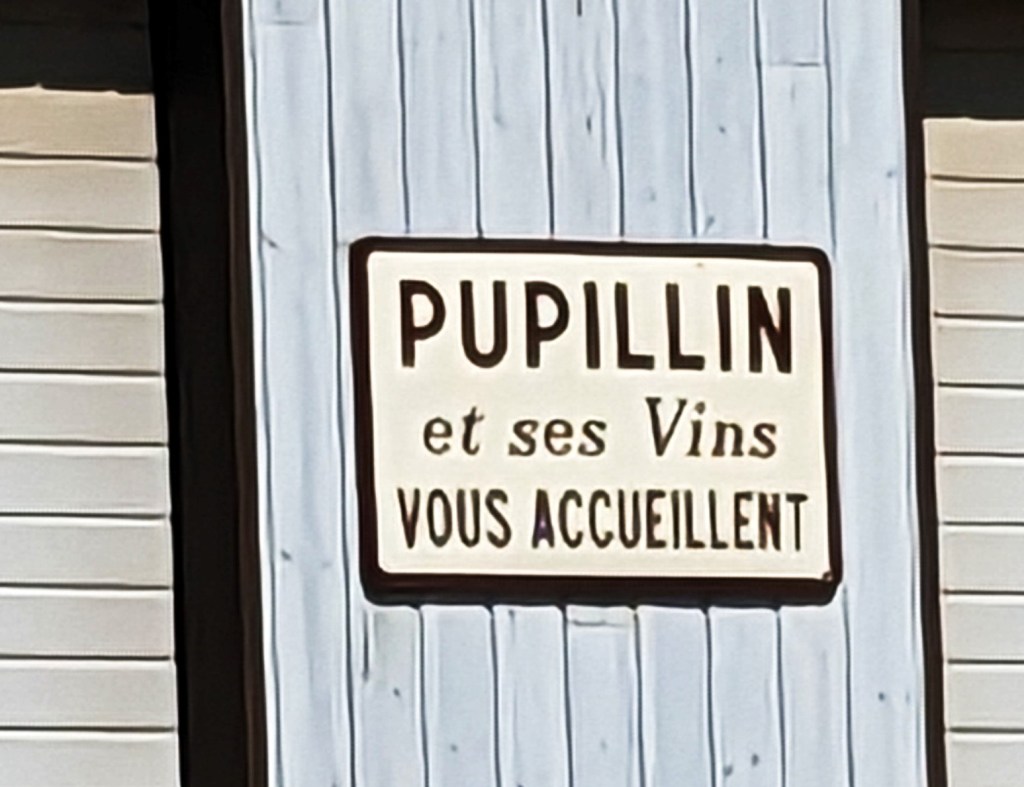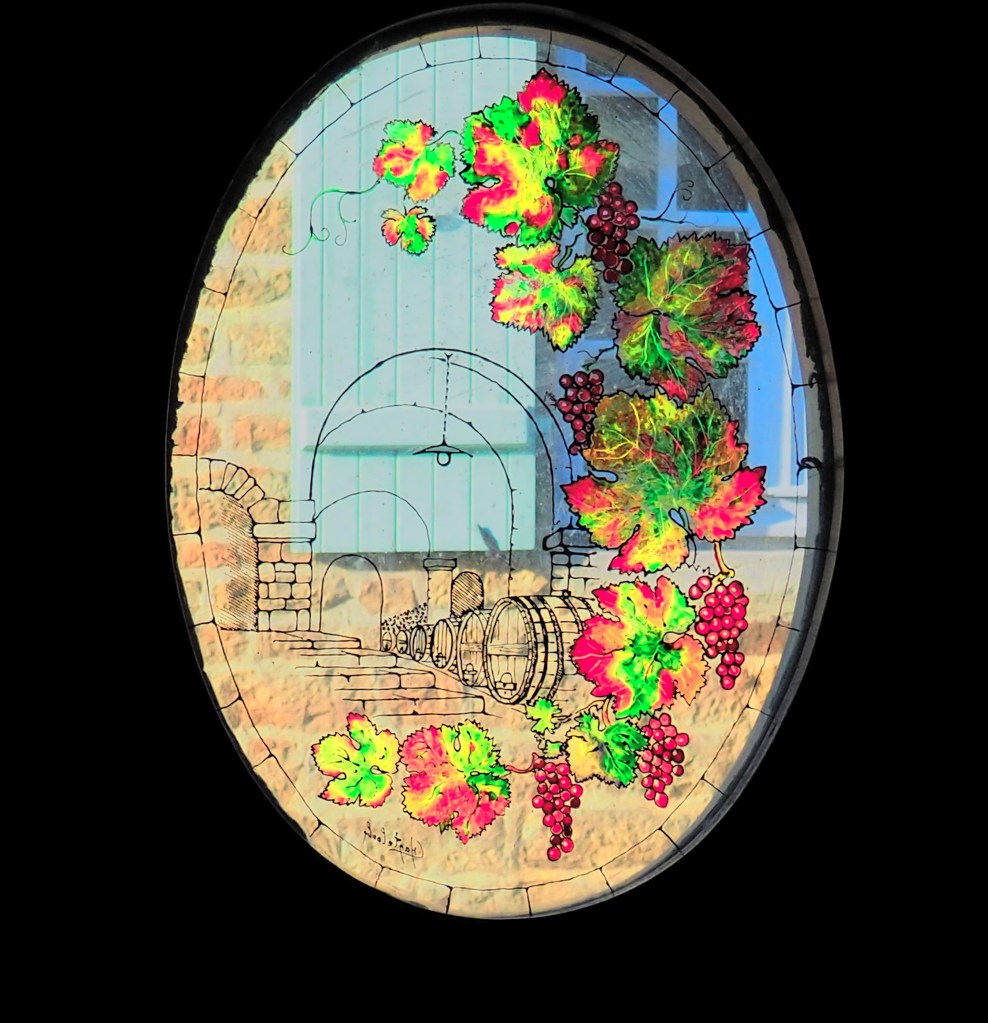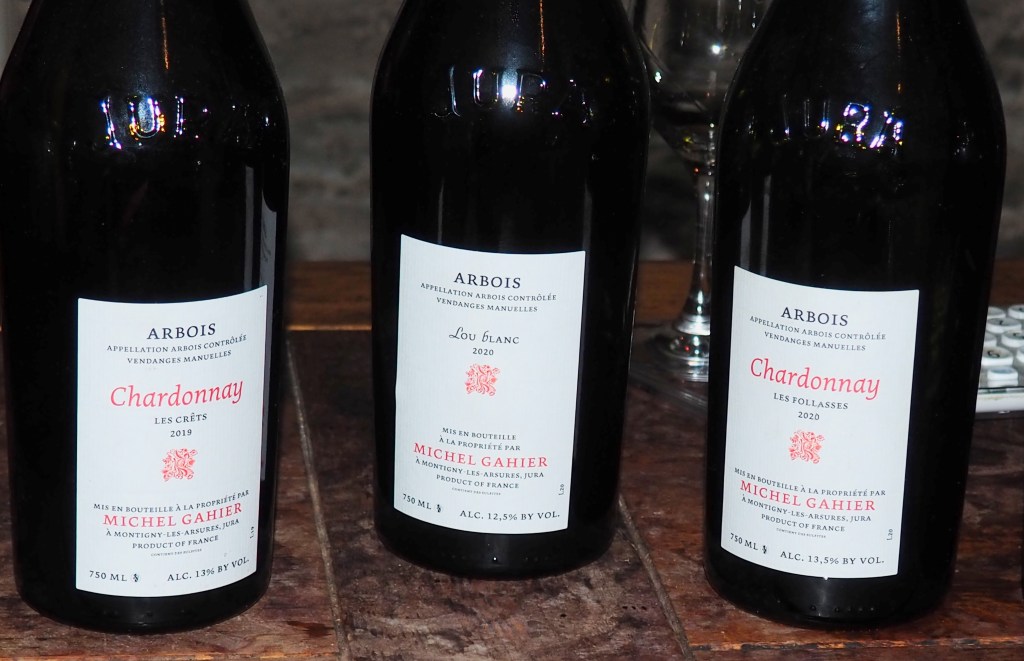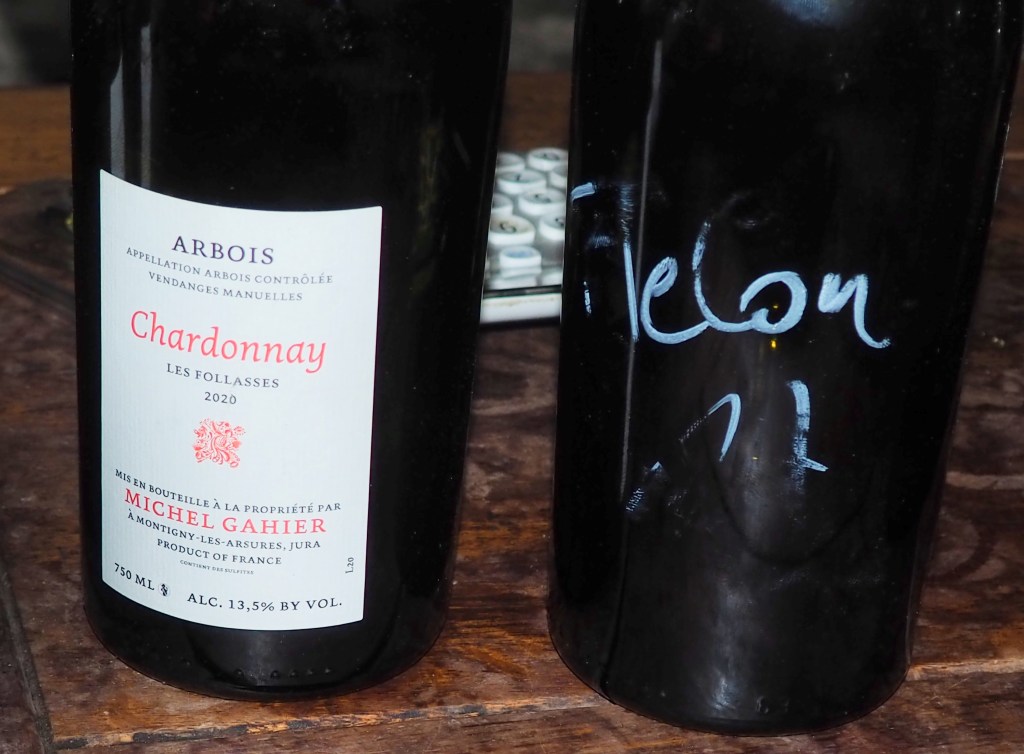

Last time I stayed in the Jura was around thirty years ago, it rained non stop and was around 13c in mid August. This time we enjoyed lovely sunshine and temperatures in the 20s. Also very different from that time is the profile of Jura wines. Thirty years ago they were, generally, unloved and unknown outside of the region. Now, they are in huge demand especially from the USA and prices have rocketed as supply is limited due to it being a small vineyard area and following a number of bad years of frost damage. I fell for Jura wines back then, the unusual grape varieties and, at the time, unfashionable embrace of oxidation. I’m glad that those who fought to make their wines well loved are earning rewards but it is sad to find many producers reaching pricing levels too high for me.
I love so much about the region and if you are intending to visit then I suggest you start by reading this guide from my friend David Crossley who has been staying in the Jura for many years and knows many of the winemakers as well as places to stay, eat and visit.
We stayed in Pupillin, near Arbois, home to Pierre Overnoy who did so much to promote Jura wines and the development of natural wines there. Our host is a relative of Overnoy, and, with his brother, has vines and Montbeliarde cows – trademarks of the region, the latter providing the milk for the region’s famous cheeses such as Conté. More on our host’s wines later. One of the attractions of the Jura is the mixed agriculture, reminiscent of the Jurancon area for example. This is not a vineyard monoculture by any means.


There is plenty of walking, beautiful scenery and interesting small towns to occupy the visitor. Arbois was home to one of my heroes Louis Pasteur and I made my second visit to his home with its basic laboratory where he did some of the research into developing Germ Theory, vaccines and saving the French wine industry from the phylloxera epidemic of the 1850s and 60s. He had laboratories in nearby Dole as well as Paris but it is fascinating to see how a genius made such profound progress in such simple surroundings in a quiet town.
Being in the area for a week also provided me with the opportunity to reunite with my great friend Steeve who worked with Jeff for almost two years. He moved back to his native region to work with winemakers there and he introduced me to some of them and we tasted together. The good news is that Steeve is returning to the Languedoc, renting 2ha of vines in the Minervois, not too far from us, and will be harvesting his first vintage this year. I look forward to visiting his new domaine and will report back here of course.
Of course the Jura is also famed for its Vin Jaune and I took the opportunity to taste some and to visit the beautiful village of Chateau Chalon, which specialises in this style of wine and has the right to call its examples by the name of the village rather than just Vin Jaune. I particularly enjoyed the Berthet-Bondet Chateau Chalon, with a delicacy, finesse and length that stood out from the others. Vin Jaune is made from Savagnin grapes aged in barrels which are not topped up allowing a thin layer of yeast (the voile) to develop, the wine taking on oxidative flavours. The barrels must be carefully watched as the wine could easily be affected by volatile acidity, even vinegar. After six years and three months the wine can be bottled, this is not a hasty process! The final wine is sherry like with dry, nutty and spicy aromas and flavours. The best examples I have had, such as Berthet-Bondet and Michel Gahier, are beautifully balanced, clean acidity, full flavoured yet light at the same time. For much more on Vin Jaune please read this recent article by David on a tasting he went to in Australia.


As mentioned I visited a number of domaines for tastings, mostly organised by Steeve. He has done a lot of work for Catherine Hannoun of Domaine De La Loue in Port Lesney, near the UNESCO site of Salins-les-Bains. Catherine offered us a number of white wines from barrel and red wine from bottle. A smallish 3.2ha of vines, not unusual for the Jura, produce the classic regional varieties and from talking with her it is clear she has taken on board a lot of advice from working alongside Emmanuel Houillon (now running Pierre Overnoy’s estate) and other leading winemakers. It was also apparent that Catherine is still trying out different approaches such as longer macerations and later picking.


Of the wines we tasted I enjoyed the whites more, particularly the Savagnins. Again Catherine is trying different barrels and my own favourite wine was a 2022 Savagnin aged in a foudre (larger barrel) rather than the standard 225l barrique. I liked the 2020 Savagnin with its citrus notes and the interesting 2022 later picked Savagnin which was fuller in the mouth and added spiciness to the citrus notes.
The following day we went along to Cramans, not far from Catherine’s base. Steeve was working with Thomas Jacquin that day bottling wines by hand. Thomas has around 1ha of vines near Arbois and has to supplement his winemaking with work for others. He spent a few years working with Jura star Stéphane Tissot and already sells his own wines around Europe including the UK (Tutto wines) though bear in mind that there is a very limited number of bottles available. I loved Thomas’ wines.


With such small quantities it would be easy for him to overwork his wines but he allows the quality of his fruit to express itself. All the wines tasted were from barrel or foudre. The Savagnin 20 carried lovely minerality under the yellow fruits, the 22 (foudre) even more depth to the flavours and that minerality cutting through and cleansing. Best of all was the Savagnin 21 with a tension, balancing fruit and, again, that cleansing minerality – long lasting flavours which seemed almost fragile, excellent. Very good too was the Poulsard 22 with its red fruit profile and lovely tannins which were part of the wine not separate and harsh like some Poulsards (or Ploussard as many here spell it) I tasted. This really needs time but will be a lovely wine. I will be trying to find Thomas’ wines whenever possible as unfortunately he carries no stock at present. Hopefully his and Steeve’s bottling that day will soon rectify that problem.
As mentioned above the gite where we stayed was run by a family which runs dairy and wine farming. Mikael Cronquand takes charge of the Overnoy Cronquand vines and winemaking whilst his brother runs the dairy side, though they obviously help each other as required. It was a real treat to discover that the wines are not only organic but would be classed as natural wines, with only some bottles having tiny sulfite addition at bottling.

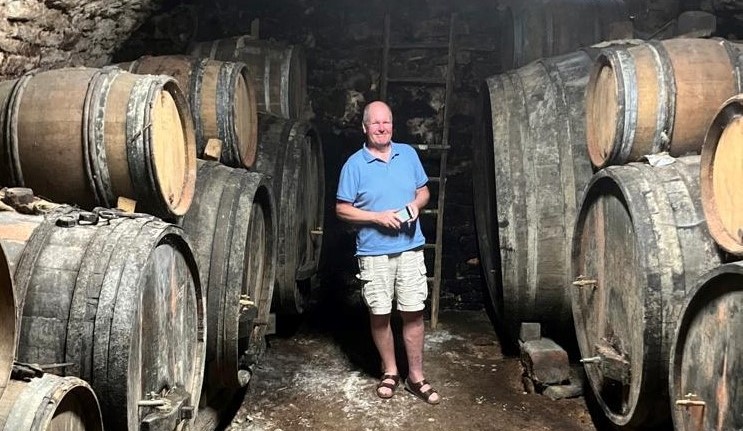
Mikael led us through a very pleasing tasting of the wines. The Crémants were a nice surprise, not something which I usually enjoy very much but the rosé and brut had clean fruit flavours as well as the acidity needed for dry sparkling wine. In classic Jura fashion we tasted reds before whites, Pupillin being the home of Ploussard, it provided most of the wines. The Ploussards 19 and 20 had a dark colour and good black fruits with a nice aromatic profile but clean and direct. Trousseau 19 was lighter in style more red fruit character, slightly surprising since Ploussard has such thin skins it is usually the lighter coloured wine.
White wines were the star though. Chardonnay Ouillé 20 was round and fruity but bone dry. Ouillé means that the barrels are topped up so that the voile does not develop. Savagnin 21 was almost austere but savoury and refreshing. On to the oxidative wines. Chardonnay 18 was reductive but spicy and white fruits to the fore, the 19 was more oxidative in style but fuller in fruit and more balanced – very nice. Savagnin 18 had spent four years in barrel and was excellent, spicy yellow fruits and bone dry again, very good balance and length. In 2018 Mikael also left a parcel of 60 year old Chardonnay vines to stay on vine for a full month after the other grapes had been picked. There remains 1g of residual sugar but there is just a hint of sweetness balanced by concentrated fruit and clean acidity. Very interesting wine, a success. Finally, another Jura speciality, Macvin. This is wine to which distilled marc is added, in this case made from their own grapes including some red grapes. Again an oxidative note and a full, spicy aperitif style wine. An excellent tasting and wines to match.
I have long been a fan of Michel Gahier‘s wines, again hard to get hold of but certainly worth the effort. Steeve a friend of Michel’s treated us in Puimisson to some of his bottles including the Vin Jaune which was a star wine of 2021 for me. Michel doesn’t seek limelight and it was a real treat for me to be invited with Steeve to visit him in Montigny-lès-Arsures near Arbois. We were there for two hours or so as Michel poured from bottle and then samples from barrel. This village labels itself as the capital of Trousseau just as Pupillin does for Ploussard (and very much Ploussard not Poulsard). Michel’s family have been making wine here since 1525 (it should be a big celebration in two years time!) and he spent a lot of time with the Jura legend Jacques Puffeney who was based in the village, indeed he now uses the barrels to make his vin jaune which once did the job for Puffeney. Quietly spoken, almost shy at first, Michel led us through 14 wines in total and every one had something special, each coming from one vineyard to express the terroir rather than the variety.
There were six Chardonnay wines, a clean, fresh 22 from new vines. Les Crêts 20, from dark marne soils, was full and fruity. Les Follasses, from white marne soils, is cleaner and fresher to my palate, the 21 with white fruits bit still closed, whilst the 22, with protective reduction, had that directness but also fuller fruit. My favourite was actually Lou Blanc raised in foudre which balanced the fruit and minerality very well. (There’s a theme emerging here with me and foudre wines!). Melon à queue rouge is a Jura grape variety which many, though not all, believe to be a type of Chardonnay. Michel is an advocate of this variety and the Melon wine La Fauquette is often regarded as his outstanding white wine, I am now one of those who would agree. The wine is made without topping up the barrel where it spent four years. The voile gives the classic oxidative note to the wine but the elegance of the fruit still shines through. The 2017 was full, nutty and spicy but clean with white fruit notes. The 22 barrel sample, obviously far from the completed wine, showed more minerality and a sherbet like acidity which lifted the apple fruit profile. Lovely wines.
The red wines are, of course, based on Trousseau grapes. Michel let us try a new vine red from a vineyard with four distinct soil types, it was fruity and had some complexity. La Vigne de Louis 22 (barrel) was still closed but spicy and direct. Le Rouge du Max is labelled Vin De France as it includes a tiny amount of Mondeuse grapes as well as Pinot Noir, all from a vineyard which was owned by his late brother. The sample from foudre gave off a waft of pepper aromas and the spicy fruit was backed with good, soft tannins. The 22 example opened in glass after being initially closed up, revealing the pepper, spice and dark fruits. Grands Vergers is regarded as Michel’s top red made from 80 year old vines and the 22 was grand indeed, big and powerful yet approachable with a fresh, black fruit character. Finally, a real treat as Michel opened a bottle of Grands Vergers 1997 – wow. Aromas of strawberry, blackberry, pepper and truffle. Flavours had a truffley note from age but big red fruits and rich, full. A memorable wine to end a memorable evening, thank you Michel.
A week in a special region. The countryside, towns, history as well as the agriculture and people make it special. The Dauphiné cycle race even passed through with last year’s Tour De France winner Jonas Vingegaard (left of photo) amongst others. I left it thirty years before returning to the Jura but I hope to return much sooner. Thank you to all those who received us for visits and especially to Steeve for organising so much of it.



